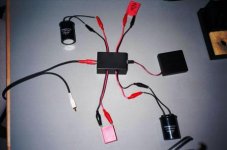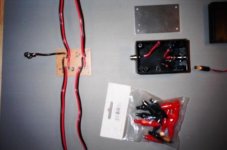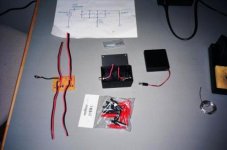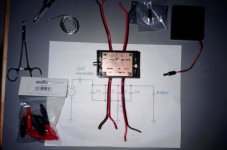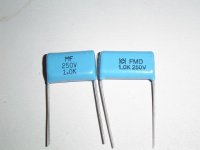DAVE,
You Da MAN! Thank you, now I can finish this little project and burn baby burn! Disco Inferno?
I agree with marking the schematic for newbies like me. I guess some of that reading is starting to pay off. I wouldn't want to send all that DC upstream into my Tuner (I think that's what would happen if the polarity was reversed or maybe the A/C wouldn't flow down, it's time to investigate that)! I am glad I checked first! It's looking good, I am taking pictures but not digital. CVS will have to put them on a CD for me when I make prints! Thanks for all your help!
Regards//Keith
You Da MAN! Thank you, now I can finish this little project and burn baby burn! Disco Inferno?
I agree with marking the schematic for newbies like me. I guess some of that reading is starting to pay off. I wouldn't want to send all that DC upstream into my Tuner (I think that's what would happen if the polarity was reversed or maybe the A/C wouldn't flow down, it's time to investigate that)! I am glad I checked first! It's looking good, I am taking pictures but not digital. CVS will have to put them on a CD for me when I make prints! Thanks for all your help!
Regards//Keith
I will run a test tonight with my favorite combo (BlackGate N 4.7uf with silver mica bypass) against the auricaps taken out of my tube pre. Both are well run in by now. The only thing that is a problem is that the auricaps are just 1.0uf, so ultimate bass performance will not be considered. The test will be run on an Amp11 as Charlize could not be brought back to life.  Her organs will be donated to new creatures arriving soon.
Her organs will be donated to new creatures arriving soon.
Greets,
Klaus
 Her organs will be donated to new creatures arriving soon.
Her organs will be donated to new creatures arriving soon.Greets,
Klaus
Hi All,
So I finished my "Cap Burn In Circuit" Saturday Morning and put it right to work!
I promised pictures of how I built it! I call it the "Cap Burn Crab." It is nice with butter but it hurts my teeth! LOL
Take a look!
Regards//Keith
Complete:
So I finished my "Cap Burn In Circuit" Saturday Morning and put it right to work!
I promised pictures of how I built it! I call it the "Cap Burn Crab." It is nice with butter but it hurts my teeth! LOL
Take a look!
Regards//Keith
Complete:
Attachments
Solen Film Cap Test 4
The first thing I noticed when switching from the Auricaps to the Solens is the highs. The cymbals sounded ever so more metallic. The brushes on the cymbals and snare on Roy Hargrove’s Once Forgotten is most telling. The sound is not etched, but this is an initial impression. I will have a better sense after listening to the entire test suite.
I noticed a pronounced sibilance on female vocals in the tests suite. On The River the piano has a “tinny” quality to it and not the rich full bodied tone I associate with a grand piano. Horns sound exceptionally good and have a certain brassy openness; this from one who played trumpet at one time. So, I think I have an excellent sense of how brass instruments sound.
The bass is full and not over powering. It seems tight and controlled. The tom-tom don’t sound quite as full (drum like) as the Auricaps. The bowing of the bass is discernable, but is closer to the MKPs in sound. The Auricaps just makes a bowed bass sound like a bowed bass is in the room. The overall sound is balanced with a litle more clarity of the highs.
The soundstage has some depth, but is not as holographic as some of the other caps tested. There is air around the performers but the overall depth is rather shallow and two dimensional. The soundstage has acceptable breadth. These caps reproduce all the inner detail I have heard to date. Despite their lack of depth they sound exceptional on symphonic works and large bands. The ambience of the recording venue is well reproduced.
The Solens make for a more forward sounding performance. I listened to the Bill Charlap Somewhere CD to test listener fatigue. The performance was acceptable and I was able to listen to the entire CD with no regret. This CD features a violin, trumpet, guitar and female vocalist.
I would like to try smaller value Solens as bypass caps. My hope would be the beautiful reproduction of horns and percussion would be captured in the bypass cap. My concern would be the overall sonic balance.
If I had not heard the lack of female sibilance with other caps this cap would be a keeper. I really enjoy the sound of horns and percussion from these caps. For those who prefer rock or R&B these caps sound louder than the MKPs and the Auricaps. They have the presence of the Obbligatos but the highs are more pronounced. This extra presence is probably due to the extra capacitance 3.3 MFD rather than the 2.X MFD. The only major knock is the lack of soundstage depth.
These caps are reasonably priced and available from multiple vendors. The Auricaps and the Solens are physically about the same size, but will only fit comfortably on the TA-10.1 PCB. The cost of the Cap less shipping from Parts Express is $3.07 (USD).
The Solens are 400 VDC metallized polypropylene and measured 3.31 and 3.30 MFD. Solens Capacitors
The first thing I noticed when switching from the Auricaps to the Solens is the highs. The cymbals sounded ever so more metallic. The brushes on the cymbals and snare on Roy Hargrove’s Once Forgotten is most telling. The sound is not etched, but this is an initial impression. I will have a better sense after listening to the entire test suite.
I noticed a pronounced sibilance on female vocals in the tests suite. On The River the piano has a “tinny” quality to it and not the rich full bodied tone I associate with a grand piano. Horns sound exceptionally good and have a certain brassy openness; this from one who played trumpet at one time. So, I think I have an excellent sense of how brass instruments sound.
The bass is full and not over powering. It seems tight and controlled. The tom-tom don’t sound quite as full (drum like) as the Auricaps. The bowing of the bass is discernable, but is closer to the MKPs in sound. The Auricaps just makes a bowed bass sound like a bowed bass is in the room. The overall sound is balanced with a litle more clarity of the highs.
The soundstage has some depth, but is not as holographic as some of the other caps tested. There is air around the performers but the overall depth is rather shallow and two dimensional. The soundstage has acceptable breadth. These caps reproduce all the inner detail I have heard to date. Despite their lack of depth they sound exceptional on symphonic works and large bands. The ambience of the recording venue is well reproduced.
The Solens make for a more forward sounding performance. I listened to the Bill Charlap Somewhere CD to test listener fatigue. The performance was acceptable and I was able to listen to the entire CD with no regret. This CD features a violin, trumpet, guitar and female vocalist.
I would like to try smaller value Solens as bypass caps. My hope would be the beautiful reproduction of horns and percussion would be captured in the bypass cap. My concern would be the overall sonic balance.
If I had not heard the lack of female sibilance with other caps this cap would be a keeper. I really enjoy the sound of horns and percussion from these caps. For those who prefer rock or R&B these caps sound louder than the MKPs and the Auricaps. They have the presence of the Obbligatos but the highs are more pronounced. This extra presence is probably due to the extra capacitance 3.3 MFD rather than the 2.X MFD. The only major knock is the lack of soundstage depth.
These caps are reasonably priced and available from multiple vendors. The Auricaps and the Solens are physically about the same size, but will only fit comfortably on the TA-10.1 PCB. The cost of the Cap less shipping from Parts Express is $3.07 (USD).
The Solens are 400 VDC metallized polypropylene and measured 3.31 and 3.30 MFD. Solens Capacitors
Hi Dave,
Just think, we could use your stone tablet to crack open the crab when the time comes to eat it! Or we could use a screw driver! (Did they invent those yet, we just learned about fire, here in the stone age).
When burning in Caps (non-polarized) for 2 weeks, will it accomplish anything to reverse the contacts after one week so it spends one week with the current/voltage flowing each way?
Obviously the polarized electrolytics only go one way. The leads on the Crab are polarized, the reds are on the + rail with the positive side of the battery and the blacks on the negative (past the resistor). I would assume the electrolytics go the same way.
Thanks!
Regards//Keith
Just think, we could use your stone tablet to crack open the crab when the time comes to eat it! Or we could use a screw driver! (Did they invent those yet, we just learned about fire, here in the stone age).
When burning in Caps (non-polarized) for 2 weeks, will it accomplish anything to reverse the contacts after one week so it spends one week with the current/voltage flowing each way?
Obviously the polarized electrolytics only go one way. The leads on the Crab are polarized, the reds are on the + rail with the positive side of the battery and the blacks on the negative (past the resistor). I would assume the electrolytics go the same way.
Thanks!
Regards//Keith
Stone - Crab
I love your sense of Humor. I will post a picture of Ye Olde Stone, hopefully sometime today.
I never considered reversing polarity. I just made sure that electrolytics were appropriately connected. The films I just made sure that I had them connected the same way for both caps. Some caps (i.e. Auricaps) have instructions as to which lead should be negative and positive.
I as a rule I orient the film caps so I can read the writing. The lead to the right of the writing I use as the positive lead, and the lead to the left I use as the negative lead.
Once hooked up I just leave ye old stone on and functioning until I need caps for the next set of tests. This last time took 3+ weeks.
Stones are pretty inanimate while crabs by nature consume things. So, keep an eye on your caps.
I love your sense of Humor. I will post a picture of Ye Olde Stone, hopefully sometime today.
I never considered reversing polarity. I just made sure that electrolytics were appropriately connected. The films I just made sure that I had them connected the same way for both caps. Some caps (i.e. Auricaps) have instructions as to which lead should be negative and positive.
I as a rule I orient the film caps so I can read the writing. The lead to the right of the writing I use as the positive lead, and the lead to the left I use as the negative lead.
Once hooked up I just leave ye old stone on and functioning until I need caps for the next set of tests. This last time took 3+ weeks.
Stones are pretty inanimate while crabs by nature consume things. So, keep an eye on your caps.
Re: Solen Film Cap Test 4
I erroneously posted the wrong CD. The correct CD was Mark O'Connor's Hot Swing Trio]/I]. In addtion to the instruments listed in the report there is an acoustic bass.
Davet said:T
The Solens make for a more forward sounding performance. I listened to the Bill Charlap Somewhere CD to test listener fatigue. The performance was acceptable and I was able to listen to the entire CD with no regret. This CD features a violin, trumpet, guitar and female vocalist.
I erroneously posted the wrong CD. The correct CD was Mark O'Connor's Hot Swing Trio]/I]. In addtion to the instruments listed in the report there is an acoustic bass.
Hi Davet
My compliments, it is really a very thorough and insightful test you have undertaken. Also, I am very content with your conclusions so far, as I have invested in several Auricaps for my Amp6s and for the preamp that I have in construction.
One question: A part from the input caps, is the rest of your Amp6 test board the standard 41Hz kit, or did you insert other modifications?
In my next Amp6 project I plan to change the signal pathway resistors to something, hopefully, better. I found some Soshin resitors from diyclub.biz, that due to their radial layout fit perfectly into the very limited space of the input and feedback resistors. Maybe resistors can be the next hot shootout test. However, due to work, family and other distractions it will be some time before I get my next Amp6 going. Sorry for OTing.
Again, thanks for your efforts.
My compliments, it is really a very thorough and insightful test you have undertaken. Also, I am very content with your conclusions so far, as I have invested in several Auricaps for my Amp6s and for the preamp that I have in construction.
One question: A part from the input caps, is the rest of your Amp6 test board the standard 41Hz kit, or did you insert other modifications?
In my next Amp6 project I plan to change the signal pathway resistors to something, hopefully, better. I found some Soshin resitors from diyclub.biz, that due to their radial layout fit perfectly into the very limited space of the input and feedback resistors. Maybe resistors can be the next hot shootout test. However, due to work, family and other distractions it will be some time before I get my next Amp6 going. Sorry for OTing.

Again, thanks for your efforts.
Amp6 Question answered.
The only modification to the Amp6 other than input caps and the switching device is the Radio Shack Alps volume control (VR).
I opted to use the stock Amp6 over the other Tripaths (TA-10.1, modified SI, Amp3, etc.) because of the 25 watts of power available. The extra headroom made it easier for me to hear the nuances of the various capacitors under test. That, and I already owned one and wanted a second.
I am curious about the possibilities with resistors in different places in the circuit. The permutations of resistor possibilities is mind boggling. In some cases the resistors could easiy out cost the amp (ala Auricaps).
In some cases the resistors could easiy out cost the amp (ala Auricaps).
Your query is not really OT. I think the test bed is a crucial part of these test and you should understand what is there or not there, so, you can make an informed decision as to what will work for you in your T-AMP.
The only modification to the Amp6 other than input caps and the switching device is the Radio Shack Alps volume control (VR).
I opted to use the stock Amp6 over the other Tripaths (TA-10.1, modified SI, Amp3, etc.) because of the 25 watts of power available. The extra headroom made it easier for me to hear the nuances of the various capacitors under test. That, and I already owned one and wanted a second.
I am curious about the possibilities with resistors in different places in the circuit. The permutations of resistor possibilities is mind boggling.
 In some cases the resistors could easiy out cost the amp (ala Auricaps).
In some cases the resistors could easiy out cost the amp (ala Auricaps).Your query is not really OT. I think the test bed is a crucial part of these test and you should understand what is there or not there, so, you can make an informed decision as to what will work for you in your T-AMP.
I posted a couple times on Shinkoh, Riken, Caddock MK132, and nude Vishay resistors in a couple places on the Trends Modding Potential thread. I'm just finding it a matter of balancing the sound between the caps and the resistors right now. There really isn't a best since it changes depending on the other parts. I've even replaced the Schotkey diode with a slower diode on the outputs and heard some noticeable changes. There's too many parts to tweak, and I'm about ready to just call it quits and be happy with what I have.
However, I still enjoy all the work that has been done and will continue to follow this thread. It's very nice to have a reference as to how a cap will sound versus another cap. Keep up the impressive work
However, I still enjoy all the work that has been done and will continue to follow this thread. It's very nice to have a reference as to how a cap will sound versus another cap. Keep up the impressive work
A Giant Killer
The biggest suprise I have heard thus far are the generic off the shelf Radio Shack metal film capacitors. This is the closest sound I have heard to the Auricaps in balance and “umph”. I have switched back and forth a number of times and there is just an overall sweetness to the sound of these caps. If you like the Obbligattos you will love the RS films.
The imposing feel of the grand pianos is right on target. The pianos have body and a balanced presentation that to me is just so much more than I ever expected. There is a beautiful balance across the audio spectrum. These caps are not as laid back as the MKPs nor are the anywhere as in your lap as the Obbligatos. The ring of brushes on cymbals is just perfect. The chimes in Pictures at an Exhibition are beyond description, for they are so life like. Tympanis have that in the gut feel that only they yield. I don’t feel there is any need to bypass these caps to get that brassy sound I referred to in the Solens report.
I detected no sibilance from the female vocals. The performance was so life like I had to repeatedly open my eyes to insure the performer was not in the room. Symphonic works reproduced the woodiness of the strings. The ambience of concert halls is portrayed to the extent that one is transported to the venue. These caps reproduce the sound of French horns with that unique tone. The quality is exaggerated when listening to French horns - compared to oboes.
The bass is full, and precise. The clarity is most obvious to me on Sly Stone’s selection from the test suite, where the bass and the bass drum can clearly be discerned as two separate instruments. On the New Orlean’s Stomp the bass register is full and toe tapping. The tom-toms have plenty of air just as one would expect from a drum kit. As to the bowed bass I put my glasses on to make sure the rosin didn’t fly into my eyes.
The sound stage has depth and is layered from front-to-rear (or rear- to-front if you so desire) very much like the Auricaps. The width of the soundstage is broad with plenty of air around the performers. All the detail I have heard from the various film caps is here with these caps, as well. One can clearly hear the closing of valves on woodwinds and the tell tale moaning of any number of keyboardist as they perform.
I opted to test this Radio Shack metal film capacitor combination, because of their immediate availability to a great number of DIYers. These caps are as close as your nearest store for most. I used two caps per side in parallel to get 2.0 MFD per side.
These capacitors are the best sounding I have heard. They are the closest to the Auricaps in sound that I have heard, and have the added bonus of the Solens “brass and percussion” sound. They are wee bit smaller in size than the Auricaps and Solens but larger than the MKPs. I place them ahead of the Auricaps and Obbligatos on value. Unfortunately they don’t look as sexy as the film Obligattos. To me these capacitors are the true giant killers. For approximately half the price of the Obbligatos or one-seventh the cost of the AUricaps. Just a superb sound ffor the money.
I hope that I am not just enchanted by my find and the sound I hear is real. Maybe BWRX and Panomaniac have an explanation as to why these caps sound so good. Is it possible lower ESR, inductance, or some other factor is the reason? Maybe there is someone amongst you who can tell who actually manufactures the capacitor for Radio Shack.
The Radio Shack Generic metal film caps (part number 272-1055) are readily accessible at your local store. The cost is $1.59 (USD) each (or $3.18 for two) and shipping is either shoe leather or gasoline. For others it may be ordered online.
The measurements for these Radio Shack metal film capacitors in parallel are 2.02 and 2.01 MFD. RS Metal Film 1.0 MFD Capacitor
The biggest suprise I have heard thus far are the generic off the shelf Radio Shack metal film capacitors. This is the closest sound I have heard to the Auricaps in balance and “umph”. I have switched back and forth a number of times and there is just an overall sweetness to the sound of these caps. If you like the Obbligattos you will love the RS films.
The imposing feel of the grand pianos is right on target. The pianos have body and a balanced presentation that to me is just so much more than I ever expected. There is a beautiful balance across the audio spectrum. These caps are not as laid back as the MKPs nor are the anywhere as in your lap as the Obbligatos. The ring of brushes on cymbals is just perfect. The chimes in Pictures at an Exhibition are beyond description, for they are so life like. Tympanis have that in the gut feel that only they yield. I don’t feel there is any need to bypass these caps to get that brassy sound I referred to in the Solens report.
I detected no sibilance from the female vocals. The performance was so life like I had to repeatedly open my eyes to insure the performer was not in the room. Symphonic works reproduced the woodiness of the strings. The ambience of concert halls is portrayed to the extent that one is transported to the venue. These caps reproduce the sound of French horns with that unique tone. The quality is exaggerated when listening to French horns - compared to oboes.
The bass is full, and precise. The clarity is most obvious to me on Sly Stone’s selection from the test suite, where the bass and the bass drum can clearly be discerned as two separate instruments. On the New Orlean’s Stomp the bass register is full and toe tapping. The tom-toms have plenty of air just as one would expect from a drum kit. As to the bowed bass I put my glasses on to make sure the rosin didn’t fly into my eyes.
The sound stage has depth and is layered from front-to-rear (or rear- to-front if you so desire) very much like the Auricaps. The width of the soundstage is broad with plenty of air around the performers. All the detail I have heard from the various film caps is here with these caps, as well. One can clearly hear the closing of valves on woodwinds and the tell tale moaning of any number of keyboardist as they perform.
I opted to test this Radio Shack metal film capacitor combination, because of their immediate availability to a great number of DIYers. These caps are as close as your nearest store for most. I used two caps per side in parallel to get 2.0 MFD per side.
These capacitors are the best sounding I have heard. They are the closest to the Auricaps in sound that I have heard, and have the added bonus of the Solens “brass and percussion” sound. They are wee bit smaller in size than the Auricaps and Solens but larger than the MKPs. I place them ahead of the Auricaps and Obbligatos on value. Unfortunately they don’t look as sexy as the film Obligattos. To me these capacitors are the true giant killers. For approximately half the price of the Obbligatos or one-seventh the cost of the AUricaps. Just a superb sound ffor the money.
I hope that I am not just enchanted by my find and the sound I hear is real. Maybe BWRX and Panomaniac have an explanation as to why these caps sound so good. Is it possible lower ESR, inductance, or some other factor is the reason? Maybe there is someone amongst you who can tell who actually manufactures the capacitor for Radio Shack.
The Radio Shack Generic metal film caps (part number 272-1055) are readily accessible at your local store. The cost is $1.59 (USD) each (or $3.18 for two) and shipping is either shoe leather or gasoline. For others it may be ordered online.
The measurements for these Radio Shack metal film capacitors in parallel are 2.02 and 2.01 MFD. RS Metal Film 1.0 MFD Capacitor
Talk about, "Out of left field!"
Dave, I've got to hand it to you! Who would ever even thought to consider them, never mind actually testing and listening?
If you said at the beginning that you were going to test these, I can just imagine the flurry of comments and banter! (Baahaaaahaha)
Now we are all crying because we spent all the extra money we had on exotic caps and now we can't even afford Alcohol to help us sooth our woes!
Well, I heard on the news that shortly after you posted that, all Radio Shack stores reported that they actually had customers buying components and not Cell Phones! (Only Kidding)
But you watch, they will be out of stock before you know it! Keep this a secret!
Nice find! This is truly the 'Coupling Cap Reference Thread!"
Regards//Keith
Dave, I've got to hand it to you! Who would ever even thought to consider them, never mind actually testing and listening?
If you said at the beginning that you were going to test these, I can just imagine the flurry of comments and banter! (Baahaaaahaha)
Now we are all crying because we spent all the extra money we had on exotic caps and now we can't even afford Alcohol to help us sooth our woes!
Well, I heard on the news that shortly after you posted that, all Radio Shack stores reported that they actually had customers buying components and not Cell Phones! (Only Kidding)
But you watch, they will be out of stock before you know it! Keep this a secret!
Nice find! This is truly the 'Coupling Cap Reference Thread!"
Regards//Keith
I really want to encourage you guys to try bypassing the caps with silver micas of small value. I got some Russian 2.2nf silver micas from ebay and when I bypassed the BlackGates with them the highs improved noticeably and prat improved also.
I can't do my cap test right now because I installed a new clock and I want to first get aquainted with the new sound before doing any cap swapping.
Greets,
Klaus
I can't do my cap test right now because I installed a new clock and I want to first get aquainted with the new sound before doing any cap swapping.
Greets,
Klaus
- Status
- This old topic is closed. If you want to reopen this topic, contact a moderator using the "Report Post" button.
- Home
- Amplifiers
- Class D
- Tripath Input Coupling Caps
